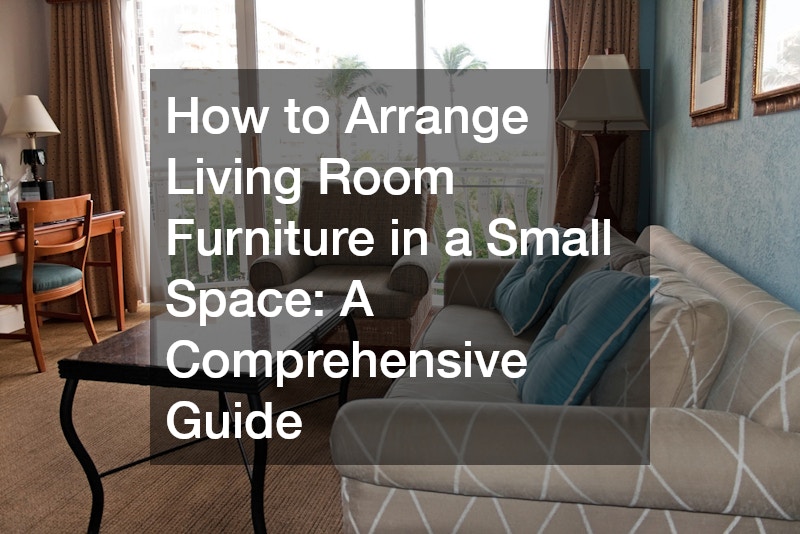Living in a small home or apartment often comes with the challenge of maximizing every square inch of space, especially in the living room, where functionality and comfort are paramount. Figuring out how to arrange living room furniture in a small space can be daunting, but with the right approach, you can create a stylish, cozy, and functional environment. This guide will take you step by step through the process of organizing your living room to get the most out of limited space.
From selecting furniture that serves multiple purposes to arranging pieces in ways that optimize traffic flow, we’ll cover everything you need to know about creating a living room that feels spacious and inviting.
1. Understanding the Room’s Dimensions and Layout
Before diving into furniture placement, the first step is to evaluate the space you have. Measure the dimensions of the room, noting the location of windows, doors, and any architectural elements like fireplaces or radiators that might affect the layout. Knowing the size and shape of your room will allow you to choose furniture that fits the space well and avoids overcrowding.
Pro Tip: Using graph paper or an online room planner can help you visualize the space better. It allows you to experiment with different layouts before you start moving heavy furniture.
Once you have your room mapped out, it’s time to think about functionality. Ask yourself:
- How do I use this space? Is the living room primarily for watching TV, entertaining guests, or relaxing with a book?
- What furniture do I already own that I can keep? Identify the key pieces you need, and consider letting go of items that take up too much space or serve little purpose.
2. Choosing the Right Furniture for Small Living Rooms
One of the key components to successfully arranging a small living room is selecting furniture that is both functional and appropriately sized for the space. Here are a few strategies for choosing the right pieces:
Opt for Multifunctional Furniture
In small spaces, every item of furniture should serve more than one function. This is especially true in living rooms, where the need for seating, storage, and entertainment space often converge. Here are a few examples of multifunctional furniture to consider:
- Sofa Beds or Futons: If your living room also serves as a guest room, a sofa bed or futon can provide a space for sleeping without sacrificing seating space during the day.
- Storage Ottomans: These are excellent for small spaces because they serve multiple purposes—offering extra seating, a footrest, and hidden storage for blankets, magazines, or remote controls.
- Nesting Tables: These space-saving tables can be tucked away when not in use and pulled out for additional surface area when entertaining guests.
Prioritize Scale and Slim Profiles
Small living rooms benefit from furniture that doesn’t overpower the space. Opt for pieces with slimmer profiles or those that are proportionate to the room’s dimensions. A few key guidelines include:
- Avoid oversized or overly deep sofas that may take up too much space.
- Choose chairs with a smaller footprint or armless designs to save space.
- Look for furniture with visible legs, as this can make the room feel more open by allowing light to flow underneath.
Pro Tip: Furniture that’s raised off the floor on legs creates the illusion of more space, making a room feel less crowded.
3. Identifying the Focal Point
In any living room, large or small, it’s essential to establish a focal point. This is the area that naturally draws the eye and becomes the centerpiece of the room’s design. Common focal points include:
- Fireplaces: Arrange seating to face the fireplace, creating a cozy, inviting feel.
- TVs or Entertainment Centers: If the living room is primarily used for watching TV, center the furniture around the screen for optimal viewing.
- Large Windows: Windows with great views can serve as focal points, with furniture arranged to enhance the view rather than obstruct it.
Once you’ve chosen a focal point, arrange your furniture around it to create a sense of cohesion. Remember that the focal point doesn’t always have to be the largest item in the room—it could be a piece of artwork or a striking light fixture.
4. Strategic Furniture Placement: Creating Flow
In small living rooms, it’s critical to think about traffic flow. You need to ensure there’s enough space for people to walk through the room comfortably, without bumping into furniture or squeezing through tight spaces. Here’s how to maintain smooth traffic flow:
- Leave space between furniture and walls: Pushing all your furniture against the walls may seem like a good way to open up the room, but in reality, it can make the space feel more cramped. Instead, float the furniture by leaving a few inches between the walls and larger pieces like sofas or bookcases.
- Create clear pathways: Make sure there are clear, unobstructed walkways between the entry points of the room and key areas, such as seating or a media console. A general rule of thumb is to leave at least 18 inches between pieces of furniture for easy navigation.
- Use Area Rugs to Define Zones: In small open-plan spaces, rugs can help to visually define areas like the living room, making them feel separate from adjacent areas like dining or kitchen spaces.
Pro Tip: To make your room feel more open, avoid placing furniture in the middle of a major traffic path. Instead, place seating and tables along the perimeter of the room or in corners.
5. Utilizing Vertical Space for Storage and Display
When floor space is limited, look upward! Vertical space offers numerous opportunities for storage and display without taking up any additional square footage. Here are a few ways to maximize your walls:
Install Floating Shelves
Floating shelves provide valuable storage for books, decor, and small plants without crowding the floor. They can also help draw the eye upward, creating the illusion of more space.
Hang Mirrors
Mirrors are a classic trick for making small spaces feel larger. A well-placed mirror can reflect light and give the room an airy, open feeling. Consider hanging a large mirror opposite a window to maximize the amount of natural light in the room.
Use Tall Furniture
Opt for taller, narrower pieces of furniture such as bookcases or armoires. These take up less floor space while providing ample storage.
6. Using Color and Lighting to Create the Illusion of Space
The colors you choose for your living room can significantly impact how spacious it feels. Light, neutral colors can make a small room feel brighter and airier, while dark colors can make it feel cozier but more enclosed. Here are some tips for using color effectively in a small living room:
Stick to a Light, Neutral Palette
Light colors such as white, light gray, soft beige, or pastel shades reflect more light, making the room feel open and expansive. You can always add pops of color through accessories like cushions, throws, and artwork.
Limit Patterns
While patterns can add visual interest to a room, too many patterns or very bold designs can overwhelm a small space. Stick to smaller, subtle patterns, or use a solid color on larger pieces of furniture.
Maximize Natural Light
If you have windows, take advantage of them! Avoid heavy drapes or curtains that block natural light. Instead, use sheer curtains or shades that allow light to filter through. Natural light makes any room feel larger.
Add Layers of Lighting
Good lighting is essential in a small living room. Use a mix of overhead lighting, task lighting (like floor or table lamps), and accent lighting to create a warm, welcoming atmosphere. Avoid relying solely on one light source, as this can make the room feel flat.
Pro Tip: Recessed lighting or wall-mounted sconces are great options for small spaces, as they don’t take up any floor space but provide excellent illumination.
7. Choosing the Right Accessories and Decor
When decorating a small living room, less is more. Too many accessories can make the space feel cluttered, so choose a few key pieces that enhance the room without overwhelming it. Here’s how to approach decor:
Minimize Clutter
Keep surfaces clear of excess decor. A clean, uncluttered space feels larger and more inviting. Use decorative trays or baskets to corral small items like remotes or coasters, and opt for minimalistic decor on shelves and tables.
Use Large-Scale Art
Instead of filling a wall with lots of small pictures, choose one or two large pieces of artwork. This approach reduces visual clutter and makes the room feel more cohesive.
Incorporate Plants
Even in small spaces, a few well-placed plants can bring life and freshness to your living room. Use tall, narrow plants in corners to draw the eye upward, or place small plants on shelves or side tables for a pop of green.
8. Arranging for Function and Comfort

Ultimately, your living room should be a place where you feel comfortable and relaxed. Don’t be afraid to experiment with different layouts until you find one that feels right for your lifestyle. Try moving furniture around to see what works best for your specific needs, whether it’s optimizing for TV viewing, creating a cozy reading nook, or making space for entertaining guests.
Consider Your Lifestyle
Think about how you and your family use the space. If you often host friends, make sure to arrange the seating to encourage conversation. If you love curling up with a good book, prioritize creating a cozy reading nook with a comfy chair and good lighting.
Conclusion: Make the Most of Your Small Living Room Space
Arranging furniture in a small living room requires careful planning and thoughtful choices, but with the right approach, you can create a space that feels comfortable, functional, and stylish. By choosing the right furniture, using vertical space, and incorporating smart design tricks like mirrors and lighting, you can maximize every square inch of your living room.
Remember, every space is unique, so take your time to experiment with layouts, and don’t be afraid to personalize the design to reflect your style and needs. With these tips, your small living room can become a beautiful, welcoming retreat that feels much larger than it is.
Final Thoughts: Embrace Creativity in Small Spaces
Arranging furniture in a small living room can be a creative and rewarding process. It invites you to rethink your relationship with space, encouraging innovative solutions that reflect your personality and lifestyle. Embrace the challenge of living in a small space and transform it into an area that resonates with comfort, warmth, and functionality.
